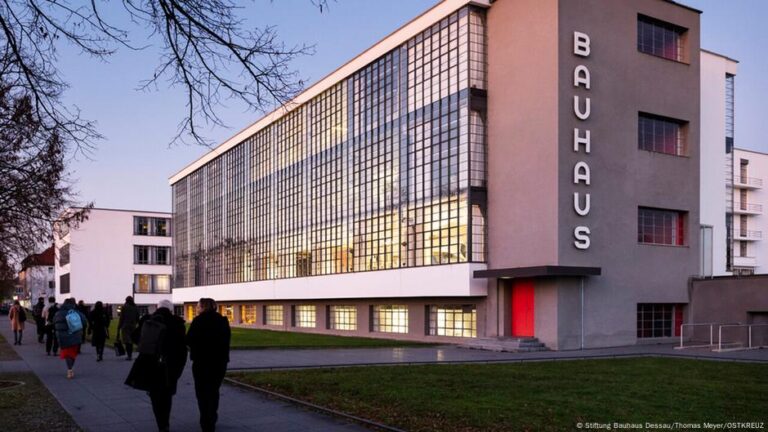The Bauhaus was arguably the world’s most influential art, architecture and design movement, and in 2025 is celebrating a century since it moved from Weimar to the city of Dessau.
But even before it kicked off the centennial event dubbed “To the Core. Bauhaus Dessau 100,” the legendary modernist institution was already making headlines.
In October 2024, Germany’s right-wing populist party Alternative for Germany (AfD) warned against “glorifying” the art and design school through the upcoming centennial.
The party complained that Bauhaus has promoted “globalist uniformity,” and submitted a motion demanding that the state parliament of Saxony-Anhalt carry out a critical reassessment of the artistic movement.
The extreme right National Socialist party also denounced the Bauhaus, calling its work “degenerate art” and “cosmopolitan” before shutting down the insitution in 1933 after Adolf Hitler came to power.
The director of the Bauhaus Dessau Foundation, Barbara Steiner told DW that the AfD motion was “quashed.” That wasn’t the end of the matter, however.
“Not a day passes without me giving an interview somewhere about the AfD,” she said.
Nonetheless, the centennial show, which kicks off September 5, will go on with exhibitions and events that focus on the evolution and use of modern materials in contemporary architecture and design.
What makes Bauhaus Dessau so special?
Architect Walter Gropius founded Bauhaus in 1919 in the city of Weimar, located in the German state of Thuringia. He envisioned a school that would bring together art, design and architecture. It would feature multidisciplinary courses in which students were able to experiment with materials used in furniture, architecture, art or design.
In 1925, Bauhaus moved to the city of Dessau, in the state of Saxony-Anhalt, after having its funding cut. In effect, the conservative political parties governing Thuringia had forced out the institution.
A year later, Gropius was able to realize his dream of having a dedicated building for his school. Its striking glass façade, divided up by vertical steel struts, has become a landmark recognized the world over. The Bauhaus style featured clean, minimalist lines and shapes that favored function over decoration.
Today, Bauhaus Dessau is a foundation focused on research and design. The building is used as an international academy for art, design and architecture.
Ideas to redesign the world
Many well-known artists and architects such as Ludwig Mies van der Rohe, Oskar Schlemmer, Laszlo Moholy-Nagy, Lyonel Feininger, Wassily Kandinsky and Paul Klee, have taught at the Bauhaus.
Its philosophy of simple and functional architecture soon found global exponents and the Bauhaus has in turn borrowed ideas from regions like Africa, including the design of structures that stay cool in hot temperatures.
“At the historical Bauhaus, the idea wasn’t simply to design the world,” explained art historian Barbara Steiner. The aim was to find solutions for a world full of challenges such as industrialization and that lead to close collaboration with industries who could provide modern building materials like steel, concrete and glass.
The road to ethical and sustainable materials
The title of the centennial, “To the Core,” is intentionally ambiguous. On the one hand, it refers to building materials such as glass, stone and wood that the students worked with when Bauhaus first opened, and the objects that were created from them. On the other, it also refers to a societal core; to the sense of community present at Bauhaus.
“The strong collective spirit, the desire to have an impact on society, was one of the driving forces behind the Bauhaus movement,” says Steiner.
These days, Bauhaus students are looking more closely at the origins of raw materials and products. Students research where the materials for the Bauhaus artists were manufactured and processed, and what negative impacts such as environmental pollution and exploitation were associated with them. They also examine the recyclability of materials, or how to develop alternative and sustainable building materials.
The Thyssenkrupp Polysius industrial company — founded in Dessau — ran cement plants in East Africa during the 1920s, creating a material that was integral to the Bauhaus’ “magnificent buildings,” noted Steiner. But what were the conditions like for the workers who “made these buildings and objects possible?”
Bauhaus celebrates centennial with multidisciplinary show
The centennial celebrations will continue into 2026. Bauhaus buildings such as the Masters’ Houses — cutting edge modernist dwellings designed for the institution’s teachers — will host various exhibitions throughout the year. “The buildings are our biggest exhibits,” said Steiner.
The traditional Bauhaus Festival will be held in the park of the city zoo with the Anhaltinisches Theater hosting events such as the so-called “material dances” by stage designer Oskar Schlemmer. The dancers’ costumes are geometrically shaped from metal, fabric and other materials.
The tradition dates back to the early days of Bauhaus, where students dressed up and paraded noisily through the city — a move which did not exactly endear them to the local public. Now the spectacle occurs in just one location.
“This time, we can’t parade through the streets,” Steiner noted, due to security restrictions. But after being verbally attacked by the AfD, organizers also fear potential agitation by Bauhaus opponents.
Will the Bauhaus have to close again?
“I think this campaign by the AfD — and it wasn’t just one, but a series of campaigns that always target modernism — has brought us a lot of attention and support,” Steiner explained.
At the same time, she is afraid of what will happen if the AfD wins an absolute majority in the state parliament of Saxony-Anhalt in the next election since party’s minister of culture would be the chairperson of the foundation board.
Bauhaus is already forming alliances with other cultural institutions to fend off smear campaigns and other attacks by the far-right party engaging in culture wars on numerous fronts.
“And then Bauhaus will have to close again,” she said, fearing an AfD win. However, there would be one major difference from 1933 when the Nazis shut down the institution.
“Back then, Bauhaus had no support among the population. Now, it has a lot of fans.”


